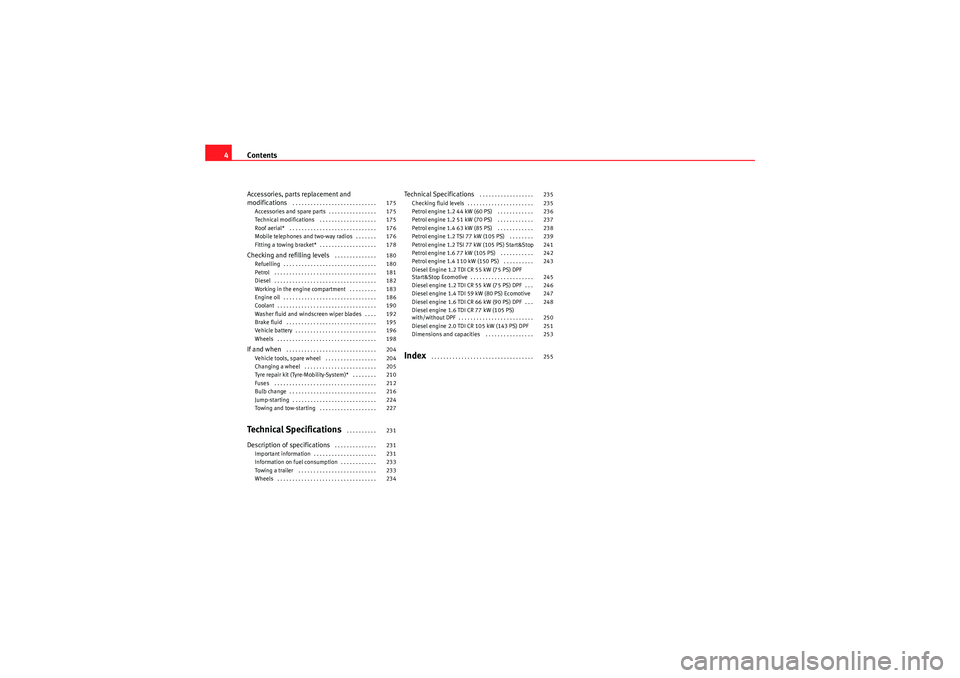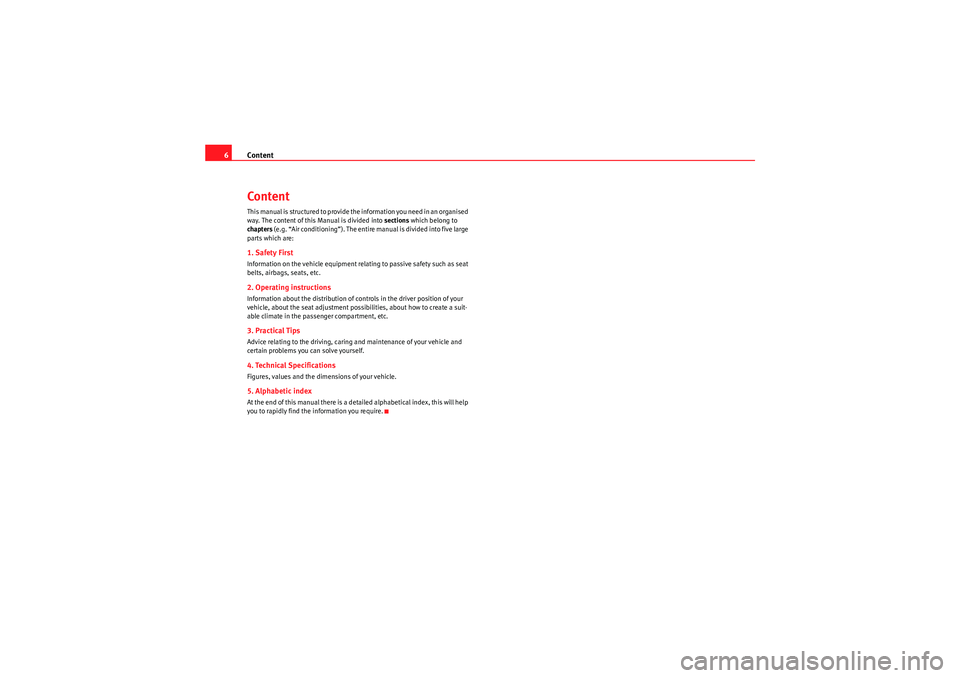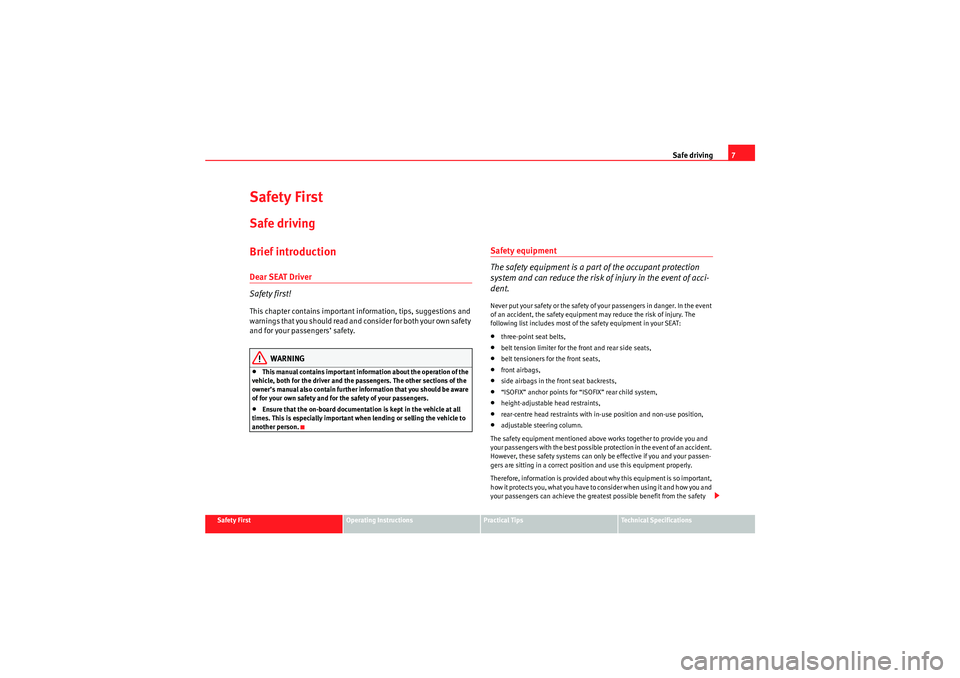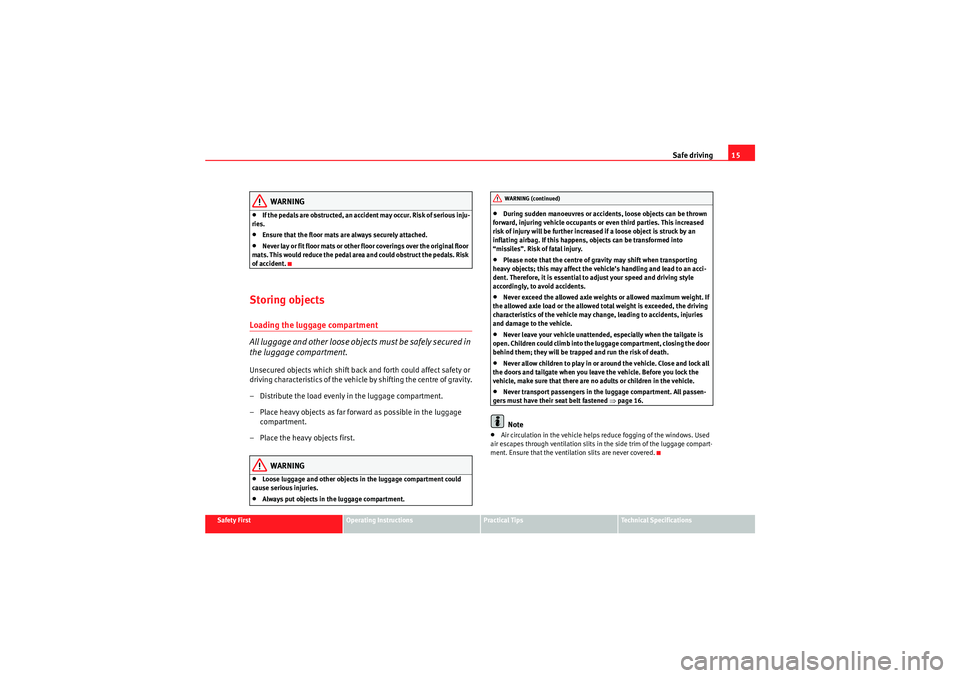technical specifications Seat Ibiza 5D 2010 Owner's manual
[x] Cancel search | Manufacturer: SEAT, Model Year: 2010, Model line: Ibiza 5D, Model: Seat Ibiza 5D 2010Pages: 266, PDF Size: 7.04 MB
Page 6 of 266

Contents
4Accessories, parts replacement and
modifications
. . . . . . . . . . . . . . . . . . . . . . . . . . . .
Accessories and spare parts . . . . . . . . . . . . . . . .
Technical modifications . . . . . . . . . . . . . . . . . . .
Roof aerial* . . . . . . . . . . . . . . . . . . . . . . . . . . . . .
Mobile telephones and two-way radios . . . . . . .
Fitting a towing bracket* . . . . . . . . . . . . . . . . . . .
Checking and refilling levels
. . . . . . . . . . . . . .
Refuelling . . . . . . . . . . . . . . . . . . . . . . . . . . . . . . .
Petrol . . . . . . . . . . . . . . . . . . . . . . . . . . . . . . . . . .
Diesel . . . . . . . . . . . . . . . . . . . . . . . . . . . . . . . . . .
Working in the engine compartment . . . . . . . . .
Engine oil . . . . . . . . . . . . . . . . . . . . . . . . . . . . . . .
Coolant . . . . . . . . . . . . . . . . . . . . . . . . . . . . . . . . .
Washer fluid and windscreen wiper blades . . . .
Brake fluid . . . . . . . . . . . . . . . . . . . . . . . . . . . . . .
Vehicle battery . . . . . . . . . . . . . . . . . . . . . . . . . . .
Wheels . . . . . . . . . . . . . . . . . . . . . . . . . . . . . . . . .
If and when
. . . . . . . . . . . . . . . . . . . . . . . . . . . . . .
Vehicle tools, spare wheel . . . . . . . . . . . . . . . . .
Changing a wheel . . . . . . . . . . . . . . . . . . . . . . . .
Tyre repair kit (Tyre-Mobility-System)* . . . . . . . .
Fuses . . . . . . . . . . . . . . . . . . . . . . . . . . . . . . . . . .
Bulb change . . . . . . . . . . . . . . . . . . . . . . . . . . . . .
Jump-starting . . . . . . . . . . . . . . . . . . . . . . . . . . . .
Towing and tow-starting . . . . . . . . . . . . . . . . . . .
Technical Specifications
. . . . . . . . . .
Description of specifications
. . . . . . . . . . . . . .
Important information . . . . . . . . . . . . . . . . . . . . .
Information on fuel consumption . . . . . . . . . . . .
Towing a trailer . . . . . . . . . . . . . . . . . . . . . . . . . .
Wheels . . . . . . . . . . . . . . . . . . . . . . . . . . . . . . . . .
Technical Specifications
. . . . . . . . . . . . . . . . . .
Checking fluid levels . . . . . . . . . . . . . . . . . . . . . .
Petrol engine 1.2 44 kW (60 PS) . . . . . . . . . . . .
Petrol engine 1.2 51 kW (70 PS) . . . . . . . . . . . .
Petrol engine 1.4 63 kW (85 PS) . . . . . . . . . . . .
Petrol engine 1.2 TSI 77 kW (105 PS) . . . . . . . .
Petrol engine 1.2 TSI 77 kW (105 PS) Start&Stop
Petrol engine 1.6 77 kW (105 PS) . . . . . . . . . . .
Petrol engine 1.4 110 kW (150 PS) . . . . . . . . . .
Diesel Engine 1.2 TDI CR 55 kW (75 PS) DPF
Start&Stop Ecomotive . . . . . . . . . . . . . . . . . . . . .
Diesel engine 1.2 TDI CR 55 kW (75 PS) DPF . . .
Diesel engine 1.4 TDI 59 kW (80 PS) Ecomotive
Diesel engine 1.6 TDI CR 66 kW (90 PS) DPF . . .
Diesel engine 1.6 TDI CR 77 kW (105 PS)
with/without DPF . . . . . . . . . . . . . . . . . . . . . . . . .
Diesel engine 2.0 TDI CR 105 kW (143 PS) DPF
Dimensions and capacities . . . . . . . . . . . . . . . .
Index
. . . . . . . . . . . . . . . . . . . . . . . . . . . . . . . . . .
175
175
175
176
176
178
180
180
181
182
183
186
190
192
195
196
198
204
204
205
210
212
216
224
227
231
231
231
233
233
234 235
235
236
237
238
239
241
242
243
245
246
247
248
250
251
253
255
Ibiza_EN.book Seite 4 Mittwoch, 1. September 2010 5:24 17
Page 8 of 266

Content
6ContentThis manual is structured to provide the information you need in an organised
way. The content of this Manual is divided into sections which belong to
chapters (e.g. “Air conditioning”). The entire manual is divided into five large
parts which are:1. Safety FirstInformation on the vehicle equipment relating to passive safety such as seat
belts, airbags, seats, etc.2. Operating instructionsInformation about the distribution of controls in the driver position of your
vehicle, about the seat adjustment possibilities, about how to create a suit-
able climate in the passenger compartment, etc.3. Practical TipsAdvice relating to the driving, caring and maintenance of your vehicle and
certain problems you can solve yourself.4. Technical SpecificationsFigures, values and the dimensions of your vehicle.5. Alphabetic indexAt the end of this manual there is a detailed alphabetical index, this will help
you to rapidly find the information you require.
Ibiza_EN.book Seite 6 Mittwoch, 1. September 2010 5:24 17
Page 9 of 266

Safe driving7
Safety First
Operating Instructions
Practical Tips
Technical Specifications
Safety FirstSafe drivingBrief introductionDear SEAT Driver
Safety first!This chapter contains important in formation, tips, suggestions and
warnings that you should read and consider for both your own safety
and for your passengers’ safety.
WARNING
•This manual contains important information about the operation of the
vehicle, both for the driver and the passengers. The other sections of the
owner’s manual also contain further information that you should be aware
of for your own safety and for the safety of your passengers.•Ensure that the on-board documentation is kept in the vehicle at all
times. This is especially important when lending or selling the vehicle to
another person.
Safety equipment
The safety equipment is a part of the occupant protection
system and can reduce the risk of injury in the event of acci-
dent.Never put your safety or the safety of your passengers in danger. In the event
of an accident, the safety equipment may reduce the risk of injury. The
following list includes most of the safety equipment in your SEAT:•three-point seat belts,•belt tension limiter for the front and rear side seats,•belt tensioners for the front seats,•front airbags,•side airbags in the front seat backrests,•“ISOFIX” anchor points for “ISOFIX” rear child system,•height-adjustable head restraints,•rear-centre head restraints with in-use position and non-use position,•adjustable steering column.
The safety equipment mentioned above works together to provide you and
your passengers with the best possible protection in the event of an accident.
However, these safety systems can only be effective if you and your passen-
gers are sitting in a correct position and use this equipment properly.
Therefore, information is provided about why this equipment is so important,
h o w i t p r o t e c t s yo u , w ha t yo u ha v e t o co nsi d e r w h e n u s i n g i t a n d h o w yo u a n d
your passengers can achieve the greatest possible benefit from the safety
Ibiza_EN.book Seite 7 Mittwoch, 1. September 2010 5:24 17
Page 11 of 266

Safe driving9
Safety First
Operating Instructions
Practical Tips
Technical Specifications
– If possible, avoid driving when you are tired or stressed.
WARNING
When driving safety is impaired during a trip, the risk of injury and acci-
dents increases.Proper sitting position for occupantsProper sitting position for driver
The proper sitting position for the driver is important for a
safe and relaxed driving.
For your own safety and to reduce the risk of injury in the event of an
accident, we recommend the following adjustments for the driver:
– Adjust the steering wheel so that there is a distance of at least 25
cm between the steering wheel and the centre of your chest
⇒fig. 1 .
– Move the driver seat forwards or backwards so that you are able to press the accelerator, brake and clutch pedals to the floor with
your knees still slightly angled ⇒.
– Ensure that you can reach the highest point of the steering wheel.
– Adjust the head restraint so that its upper edge is at the same level as the top of your head, or as close as possible to the same
level as the top of your head ⇒ fig. 2.
– Move the backrest to an upright position so that your backrests completely against it.
Fig. 1 The proper
distance between driver
and steering wheel
Fig. 2 Proper head
restraint position for
driver
Ibiza_EN.book Seite 9 Mittwoch, 1. September 2010 5:24 17
Page 13 of 266

Safe driving11
Safety First
Operating Instructions
Practical Tips
Technical Specifications
•If your physical constitution prevents you from maintaining the
minimum distance of 25 cm, contact a specialised workshop. The work-
shop will help you decide if special specific modifications are necessary.•Always keep your feet in the footwell when the vehicle is moving; never
rest them on the dash panel, out the window or on the seat. An incorrect
sitting position exposes you to an increased risk of injury in case of a
sudden braking or an accident. If the airbag is triggered, you could sustain
severe injuries due to an incorrect sitting position.•To reduce the risk of injury to the front passenger in events such sudden
braking manoeuvres or an accident, never travel with the backrest tilted far
back! The airbag system and seat belts can only provide optimal protection
when the backrest is in an upright position and the front passenger is
wearing his or her seat belt properly. The further the backrests are tilted to
the rear, the greater the risk of injury due to incorrect positioning of the
belt web or to the incorrect sitting position!•Adjust the head restraint properly in order to achieve maximum
protection.
Correct sitting position for passengers in the rear seats
Passengers in the rear seats must sit up straight, keep their
feet on the footwells, have the rear central head restraint
positioned for use and wear their seat belts properly.To reduce the risk of injury in the event of a sudden braking
manoeuvre or an accident, passengers on the rear bench seat must
consider the following:
– Adjust the head restraint to the correct position ⇒page 12. – Keep both feet in the footwell in front of the rear seat.
– Fasten your seat belt securely
⇒page 16.
– Use an appropriate child restraint system when you take children in the vehicle ⇒page 37.
WARNING
•If the passengers on the rear seat are not sitting properly, they could
sustain severe injuries.•Adjust the head restraint properly in order to achieve maximum protec-
tion.•Seat belts can only provide optimal protection when backrests are in an
upright position and the passengers are wearing their seat belts properly.
If passengers on the rear seat are not sitting in an upright position, the risk
of injury due to incorrect positioning of the seat belt increases.
WARNING (continued)
Ibiza_EN.book Seite 11 Mittwoch, 1. September 2010 5:24 17
Page 15 of 266

Safe driving13
Safety First
Operating Instructions
Practical Tips
Technical Specifications
Rear head restraintsThe rear head restraints have 2 positions:•Raised position or position for use ⇒ fig. 5. In this position, the head
restraint is used normally, protecting the occupant of the rear seats, along
with the rear seat belts.•Rest position, not in use ⇒fig. 5 . This position improves the driver’s
rear visibility.
To fit the head restraint in position for use , pull on the edges with both
hands in the direction of the arrow. To place it in rest position , lower the
head restraint.WARNING
Whenever a passenger is seated on the rear central seat, the head restraint
should be placed in the position for use .
Note
Note the instructions on the head restraints adjustment.Examples of incorrect sitting positions
An incorrect sitting position can lead to severe injuries to
occupants.Seat belts can provide optimal protection only when the belt webs
are properly positioned. Incorrect sitting positions substantially
reduce the protective function of se at belts and increase the risk of
injury due to incorrect seat belt position. As the driver, you are
responsible for all vehicle occupants, especially children.
– Never allow anyone to assume an incorrect sitting position in the vehicle while travelling ⇒.The following list contains examples of sitting positions that could be
dangerous for all occupants. The list is not complete, but we would like to
make you aware of this issue.
Therefore, whenever the vehicle is in motion:•Never stand in the vehicle,•never stand on the seats,•never kneel on the seats,•never tilt your backrest far to the rear,•never lean against the dash panel,•never lie on the rear bench,•never sit on the front edge of a seat,•never sit sideways,
Fig. 5 Adjusting the rear
head restraints
AA
AB
AA
AB
AA
Ibiza_EN.book Seite 13 Mittwoch, 1. September 2010 5:24 17
Page 17 of 266

Safe driving15
Safety First
Operating Instructions
Practical Tips
Technical Specifications
WARNING
•If the pedals are obstructed, an accident may occur. Risk of serious inju-
ries.•Ensure that the floor mats are always securely attached.•Never lay or fit floor mats or other floor coverings over the original floor
mats. This would reduce the pedal area and could obstruct the pedals. Risk
of accident.
Storing objectsLoading the luggage compartment
All luggage and other loose objects must be safely secured in
the luggage compartment.Unsecured objects which shift back and forth could affect safety or
driving characteristics of the vehicle by shifting the centre of gravity.
– Distribute the load evenly in the luggage compartment.
– Place heavy objects as far forward as possible in the luggage compartment.
–Place the heavy objects first.
WARNING
•Loose luggage and other objects in the luggage compartment could
cause serious injuries.•Always put objects in the luggage compartment.
•During sudden manoeuvres or accidents, loose objects can be thrown
forward, injuring vehicle occupants or even third parties. This increased
risk of injury will be further increased if a loose object is struck by an
inflating airbag. If this happens, objects can be transformed into
“missiles”. Risk of fatal injury.•Please note that the centre of gravity may shift when transporting
heavy objects; this may affect the vehicle’s handling and lead to an acci-
dent. Therefore, it is essential to adjust your speed and driving style
accordingly, to avoid accidents.•Never exceed the allowed axle weights or allowed maximum weight. If
the allowed axle load or the allowed total weight is exceeded, the driving
characteristics of the vehicle may change, leading to accidents, injuries
and damage to the vehicle.•Never leave your vehicle unattended, especially when the tailgate is
open. Children could climb into the luggage compartment, closing the door
behind them; they will be trapped and run the risk of death.•Never allow children to play in or around the vehicle. Close and lock all
the doors and tailgate when you leave the vehicle. Before you lock the
vehicle, make sure that there are no adults or children in the vehicle.•Never transport passengers in the luggage compartment. All passen-
gers must have their seat belt fastened ⇒page 16.Note
•Air circulation in the vehicle helps reduce fogging of the windows. Used
air escapes through ventilation slits in the side trim of the luggage compart-
ment. Ensure that the ventilation slits are never covered.WARNING (continued)
Ibiza_EN.book Seite 15 Mittwoch, 1. September 2010 5:24 17
Page 19 of 266

Seat belts17
Safety First
Operating Instructions
Practical Tips
Technical Specifications
The warning lamp
in the instrument panel lights up
1) if the driver or
passenger seat belt is not fastened
1) when the ignition is switched on. More-
over, an acoustic signal
1) is heard on exceeding 25 km/h. This acoustic
signal stops when the seat belt is fastened.
The warning lamp*
is switched off if the driver seat belt is fastened while
the ignition is switched on.
1)Depending on the model version
Ibiza_EN.book Seite 17 Mittwoch, 1. September 2010 5:24 17
Page 21 of 266

Seat belts19
Safety First
Operating Instructions
Practical Tips
Technical Specifications
travelling just before the impact. This example applies not only to head-on
collisions, but to all accidents and collisions.
The danger of not using the seat belt
The general belief that the passengers can protect them-
selves with their hands in a minor collision is false.
Even at low speeds the forces acting on the body in a collision are so great
that it is not possible to brace oneself with one’s hands. In a frontal collision,
unbelted passengers are thrown forward and will make violent contact with
the steering wheel, dash panel, windscreen or whatever else is in the way
⇒
fig. 8 .
The airbag system is not a substitute for seat belts. When triggered, airbags
provide only additional protection. All occupants (including the driver) must
wear seat belts properly during the trip. This will reduce the risk of severe
injuries in the event of an accident – regardless of whether an airbag is fitted
for the seat or not.
Note that airbags can be triggered only once. To achieve the best possible
protection, the seat belt must always be worn properly so that you will be
protected in accidents in which no airbag is deployed.
It is also important for the rear passengers to wear seat belts properly, as they
could otherwise be thrown forward violently in an accident. Rear passengers
who do not use seat belts endanger not only themselves but also the front
occupants ⇒fig. 9 .
Fig. 8 A driver not
wearing a seat belt is
thrown forward violently.
Fig. 9 The unbelted rear
passenger is thrown
forward violently, hitting
the driver wearing a seat
belt.
Ibiza_EN.book Seite 19 Mittwoch, 1. September 2010 5:24 17
Page 23 of 266

Seat belts21
Safety First
Operating Instructions
Practical Tips
Technical Specifications
•Fasten your seat belt before every trip - even when driving in town. The
o t h e r pas s e nge rs m u s t al s o w e ar t h e s ea t b e l ts a t al l t i m e s , o t h e r w is e t h e y
run the risk of being injured.•The seat belt cannot offer its full protection if the seat belt is not posi-
tioned correctly.•Never allow two passengers (even children) to share the same seat belt.•Keep both feet in the footwell in front of your seat as long as the vehicle
is in motion.•Never unbuckle a seat belt while the vehicle is in motion. Risk of fatal
injury.•The seat belt must never be twisted while it is being worn.•The seat belt should never lie on hard or fragile objects (such as glasses
or pens, etc.) because this can cause injuries.•Do not allow the seat belt to be damaged or jammed, or to rub on any
sharp edges.•Never wear the seat belt under the arm or in any other incorrect posi-
tion.•Loose, bulky clothing (such as an overcoat over a jacket) impairs the
proper fit and function of the belts, reducing their capacity to protect.•The slot in the seat belt buckle must not be blocked with paper or other
objects, as this can prevent the latch plate from engaging securely.•Never use seat belt clips, retaining rings or similar instruments to alter
the position of the belt webbing.•Frayed or torn seat belts or damage to the connections, belt retractors
or parts of the buckle could cause severe injuries in the event of an acci-
dent. Therefore, you must check the co ndition of all seat belts at regular
intervals.•Seat belts which have been worn in an accident and stretched must be
replaced by a specialised workshop. Renewal may be necessary even if
there is no apparent damage. The belt anchorage should also be checked.
•Do not attempt to repair a damaged seat belt yourself. The seat belts
must not be removed or modified in any way.•The belts must be kept clean, otherwise the retractors may not work
properly.
Seat beltsSeat belt adjustment
The seat belts for the front and rear occupants are locked into
position by a latch.The seat belt cannot offer its full protection if the seat belt is not
positioned correctly.
WARNING (continued)
WARNING (continued)
Fig. 11 Belt buckle and
latch plate of seat belt
Ibiza_EN.book Seite 21 Mittwoch, 1. September 2010 5:24 17